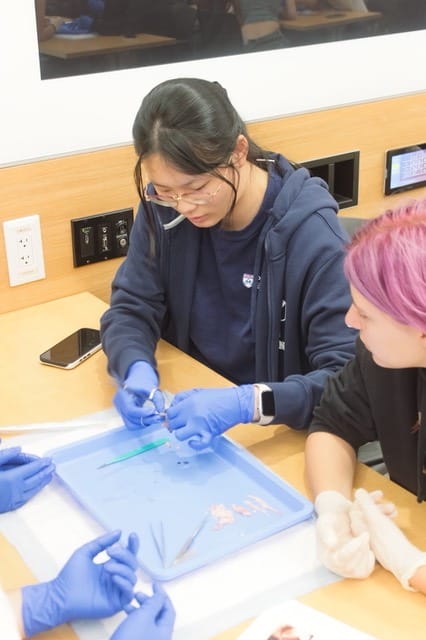The first thing Eileen (Runing) Guan noticed wasn’t the scalpel. It was the sound: the steady click of stainless steel on stainless tray, the soft elastic snap of gloves, the instructor’s calm count— one-and-two-over the dummy’s chest. In the University of Pennsylvania’s pre-med immersion, she learned CPR by keeping time, suturing by learning tension, and anatomy by holding a cow’s eye up to the light until the lens turned into a tiny, perfect magnifying glass. The program promised a survey of medicine; Eileen found something else too—a feeling that the gap between wanting to help and knowing how to help could be crossed by practice, patience, and a willingness to be coached.
Medicine has been the background music of Eileen’s life. With a father in surgery and a mother in clinical practice, hospital corridors weren’t just places of emergency; they were places of ordinary kindness and well-rehearsed systems. She remembers watching her mother move through an outpatient clinic: the speed of triage, the diplomacy of difficult conversations, the dignity offered by a clinician who refused to be rushed on the moments that mattered. At home, the talk might turn to cases or research, but what stuck with Eileen wasn’t prestige or procedure—it was presence. The thing she wanted to learn first wasn’t theory. It was how to stand there—useful—when someone is afraid.
UPenn gave her a proving ground. “Hands-on” wasn’t a brochure phrase; it was repetition until muscle memory formed. In one lab, she learned the bite-and-throw rhythm of suturing, coaxing needle and thread through synthetic skin without tearing it. In another, the lumbar puncture simulation demanded stillness and respect for anatomy—a reminder that skill starts with humility. Even CPR, the most familiar procedure, felt new when her hands took responsibility for keeping time. Each station left a mark: the antiseptic smell she can now summon at will, the instructor’s feedback loop—observe, attempt, correct, attempt again. Whenever doubt rose, practice answered it.
But if UPenn trained her hands, a very different space trained her heart. Through a hospital–civic partnership, Eileen began volunteering in a cancer-care setting, supported by a social worker who helped her onboard thoughtfully. She arrived prepared to file forms, escort patients, and perform the quiet chores that keep a unit running smoothly. What she didn’t expect was how much of cancer care unfolds in the waiting: scan results that may not come today, nausea that might not go away this week, questions that feel too heavy to ask out loud. She grew attuned to small signals—the way someone sits when the day is too long, the way a spouse hovers when they want to be brave. It reinforced something she’d sensed in her mother’s clinic: most of care is not crisis; it’s accompaniment.
That realisation sent her back to her desk, not out of retreat, but out of resolve. Eileen began drafting a plain-language reflection journal for middle-aged cancer patients, translating key psychological ideas—such as coping strategies and simple mood check-ins—into concise, gentle pages with ample room to write. The point wasn’t to diagnose; it was to give patients a vocabulary for what they were living through and a structured way to notice small shifts: “Today I felt less dizzy after walking,” “I asked one more question in my appointment,” “I called the friend I keep putting off.” She shared the draft with the social worker who had guided her entry into the unit; the feedback pushed her toward clarity and away from jargon, toward prompts that invited honesty without pressure. In the short term, she aims to pilot the journal with a small group; in the longer term, she envisions a simple digital version, accompanied by brief workshops that teach families how to ask and answer questions more effectively together.
If you ask Eileen why oncology, she doesn’t reach for a grand abstraction. She reaches for balance. The field demands technical excellence—pattern recognition, steady hands, and relentless study—and yet none of that negates the need for human presence. If anything, the two intensify each other. “I want to be the kind of doctor who can place a line and also place a hand,” is how she frames it: the same precision that keeps a suture line neat can keep a conversation safe; the same discipline that prepares you for a procedure prepares you to sit in silence without forcing optimism. UPenn didn’t settle that question for her; it focused it. Volunteering didn’t answer it either; it gave the question a face.
There’s also a research project running beneath her plans. Eileen has contributed to cancer-informatics work that builds co-expression networks across tumour types—a technical project that sharpened her instinct to translate complexity into usefulness. Ask her about it, and she will explain in plain English: we look for patterns that help clinicians understand why one patient’s disease behaves differently from another’s, so decisions can be more personal. That habit—start with the human use-case, then climb backwards into the math—shows up again in the way she designed the journal. The proof she wants isn’t “clever” or “novel”; it’s whether someone in chemo reaches for it a second time.
If her life so far sounds linear—pre-med program, hospital volunteering, research exposure—that is only because she has chosen, recently, to make it so. Eileen talks about a time when medicine was a constellation: luminous but scattered points of inspiration. What she is doing now is drawing the lines between them: a hands-on lab that teaches patience, a clinic shift that teaches attention, and a writing project that teaches language for progress. Each line insists on the same discipline: practice. On the UPenn floor, that meant another suture thrown cleanly. In the clinic, it means remembering a name, noticing a wince. On the page, it means cutting a sentence until it contains only the one thing it needs to convey.
Her near-term plan is unglamorous and exactly right: finish the pilot-ready draft, secure the necessary approvals, test the journal in a small and time-bound manner, and measure the changes carefully and humbly. If it shows promise, she’ll iterate—ever the student of systems, she can imagine a minimalist app or a print-at-home PDF that hospitals and nonprofits can share without friction. None of this, she’s quick to add, substitutes for treatment or professional counselling. The goal is smaller and therefore harder: to make the days in between treatments more bearable, to give patients and families a shared practice for noticing.
Toward the end of our conversation, Eileen returns to the first day at UPenn and the sensation of her hands hovering over the chest of the CPR mannequin. “I was counting in my head and could hear the room even as I focused on the compression,” she says. “The instructor told me to keep time with the metronome. I remember thinking, ‘I can learn this.’ And if I can learn this, I can learn the next thing.” That is the promise she is keeping with herself now—not a vow to be a hero, but a decision to be ready. Before the white coat, there is the work. She is already doing it.
The Editorial Team at Healthcare Business Today is made up of experienced healthcare writers and editors, led by managing editor Daniel Casciato, who has over 25 years of experience in healthcare journalism. Since 1998, our team has delivered trusted, high-quality health and wellness content across numerous platforms.
Disclaimer: The content on this site is for general informational purposes only and is not intended as medical, legal, or financial advice. No content published here should be construed as a substitute for professional advice, diagnosis, or treatment. Always consult with a qualified healthcare or legal professional regarding your specific needs.
See our full disclaimer for more details.








